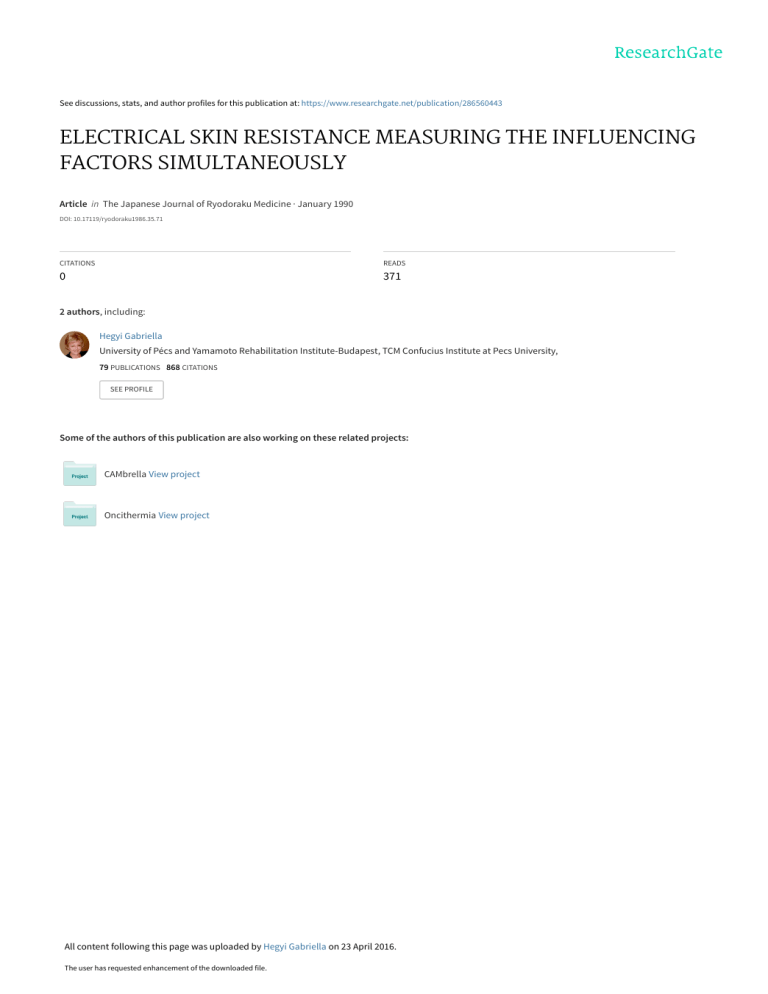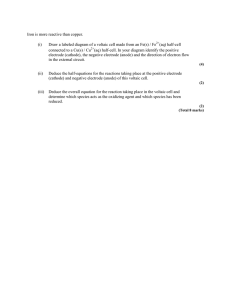
See discussions, stats, and author profiles for this publication at: https://www.researchgate.net/publication/286560443 ELECTRICAL SKIN RESISTANCE MEASURING THE INFLUENCING FACTORS SIMULTANEOUSLY Article in The Japanese Journal of Ryodoraku Medicine · January 1990 DOI: 10.17119/ryodoraku1986.35.71 CITATIONS READS 0 371 2 authors, including: Hegyi Gabriella University of Pécs and Yamamoto Rehabilitation Institute-Budapest, TCM Confucius Institute at Pecs University, 79 PUBLICATIONS 868 CITATIONS SEE PROFILE Some of the authors of this publication are also working on these related projects: CAMbrella View project Oncithermia View project All content following this page was uploaded by Hegyi Gabriella on 23 April 2016. The user has requested enhancement of the downloaded file. 日良 自律3号 Lecture 一9(71)一 at the 1 st International Ryodoraku Congress Oct 9, 1988 —Miyazaki— ELECTRICAL SKIN THE FACTORS RESISTANCE MEASURING INFLUENCING SIMULTANEOUSLY Authors : Dr. Gabriella HEGYI* Dr. Ajandok EORY, PhD.** Introduction In his recently diagnostic published acupuncture paper / 1 / Tiller asks the question : "What do electrodermal instruments really measure?" To answer this question authors had made more than 12,000 measurements influencing measured on 30 healthy factors : some of them was eliminated simultaneously, skin was standardized race of the volunteers. e. g. skin temperature, volunteers taking into account e. g. electrode polarisation, others were room humidity, etc. The preparation as well as the hour of the day of the measurements, Let us give some informations the of the the age, sex and on the most important influencing factors now. Methodological Electrode considerations polarization may significantly influence the accuracy of measured skin resist- ance values. The error due to this effect may exceed 100%. Electrode polarization is the result of change in the potential of the electrodes, while current is conducted away. The effect of polarization appears as a plus resistance, i. e. it causes the measured value to be larger, then the real value. The best arrangement for the measurements eliminating polarization is the so called "four electrode" technique. The four electrodes are placed on the skin in the form of two electrodes, both having two concentric elements. / Fig. 1 / The outer, ring shaped electrodes are for the penetration monitoring of the current onto the skin and the inner, disk shaped ones are used for the potential drop between the two sets of electrodes connecting them to an amplifier. / Fig. 2 . / In the simplest case the circuit resistance "R" is determined R =—V I by Ohm' Law, i. e. 一10(72)一 日良 自律3号 where V is the potential The resistance difference of the source and I is the current. may be measured a. / Constant by the Current Method when a constant in the present case into the electrodes current is passed into the circuit Fig. 3 . on the skin and we measure the resulting potential drop. b. / Constant Voltage Method, when a constant through the electrodes Either method and current elimination potential / and we measure the resulting may be used as long as parameter difference is applied to the skin / current. / Fig. 4 . / values of the measurement, i.e. voltage are chosen very carefully. However from the point of view of the circuitry for of electrode the resulting potential polarization the constant current density is maintained to the skin resistance, In this case and a constant over the skin. In the case of the " 3 Electrode Technique", onto the skin through current method is preferable. drop is linearly proportional the constant intensity current is introduced electrodes A and B. The voltage drop at the "A" active electrode can be measured by using electrode "C" in conjunction with a high input impedance amplifier. / Fig. 5 ./ The high input impedance C—A" circuit eliminating insures that only negligible current flows in the "A—amplifier— the electrode polarization. This technique unipolar electrode system, that is when a "neutral" electrode an "active" electrode with smaller surface is applied. The experimental procedure Before each measurement can be used only in the with greater surface is fixed and the soap and water cleaned surface was also carefully cleaned by alcohol in a solution of 10%. After having the electrodes wet / by a 0.05 mo1 NaCl solution, which is isotonic with human sweat /, the sensor was placed on the skin. First the resistance, next the temperature value of the skin was registered. to be performed under constant Considering a bipolar electrode The sensor allowed all measurements electrode pressure. system, the resistance value that was measured between the two electrodes, that were placed on the skin was divided by two. This way the average resistance value of the skin under one of the electrodes 0.38 was used, i. e. normalizing The skin resistance to 1 of, since the individual value, as it was normalized the effect of the relative was obtained. A normalizing humidity electrode surface area was 38 run. to 1 cnf,gets further modified by including of the experimental environment. The normalized ance value is reduced by 2.8% for each 1 % increase in relative humidity Maulsby and Edelberg / 3 / showed that there is a linear relationship rithm of the skin resistance simultaneously measured and the skin temperature and the skin resistance factor of resist- / 2 /. between the loga- / Fig. 61. From their result it was was further corrected to a standard 30°C skin temperature. To compare the resistance most appropriate values obtained at the same point on different method seems to be by using weighted ing formula : n = E Ri • Ri, ave E Ri, ave where averaging according individuals, the to the follow- 日良自律3号 一11(73)一 Let us take an example. The measured electrodes value was 542 kohm . Under one of the 271 kohm. To express this skin resistance in terms of resistance per unit therefore skin resistance area : 271 x 0.38 = 103 kohm. To take into account the measured 56% relative humidity : 103 x 0.972 = 100 kohm. To include the effect of the skin temperature measured to be 32.2°C, the skin resistance 110 kohm. According is normalized to the above algorithm , which was simultaneously to 30°C temperature by : 100 x 1 .107 = the data processing was done by a computer program. Results Fig. 7. illustrates the measurements example. The data are starting By connecting the measured side of the forefinger skin resistance values obtained out on the dorsal part of the hand as an with the resistance on Fig. 7. are summarized at approximately 300 points values increase. at the same heights, one can see that the dorsal and the dorsal part of the hand close to the forefinger values. This is in contrast The data illustrated Measured carried from the nails and going inward the resistance in Table we have have the highest drop measured at Hegu area. 1. sought the answer to the following question, too : -How the skin resistance varies to the different parts of the body ? We belive that our approach by this exact skin resistance mapping is an important contribution to Ryodoraku practice and science. References 1. Tiller, W. A. : What Measure Do Electrodermal Am. J. of Acupuncture, Diagnostic Acupuncture Instruments Really 15 / 1 /, 15 - 23, 1987. 2. EOry, A. , Kuzmann, E. and Adam, Gy. : Exact Mapping Of Skin Resistance Relationships When The Simultaneous Action Of Influencing Factors Are Considered / in Hungarian / Hung. Psychological 3. Review of Hung. Acad. Sci. , 27 / 4 /, 514 - 527, 1970. Maulsby, R. L. and Edelberg, R. : The Interrelationship Between The Galvanic Skin Response, Basal Resistance, and Temperature J. of Comparative and Physiological Psychology, 53, 475 - 479 - 1960. (Figures have not been received.) x Address : Dr. G HEGYI Budapest, IX. Zoltan u. 16. HUNGARY x x Address : Dr. AEORY H- 1131 Budapest, X III. Sollner u. 24. HUNGARY View publication stats




